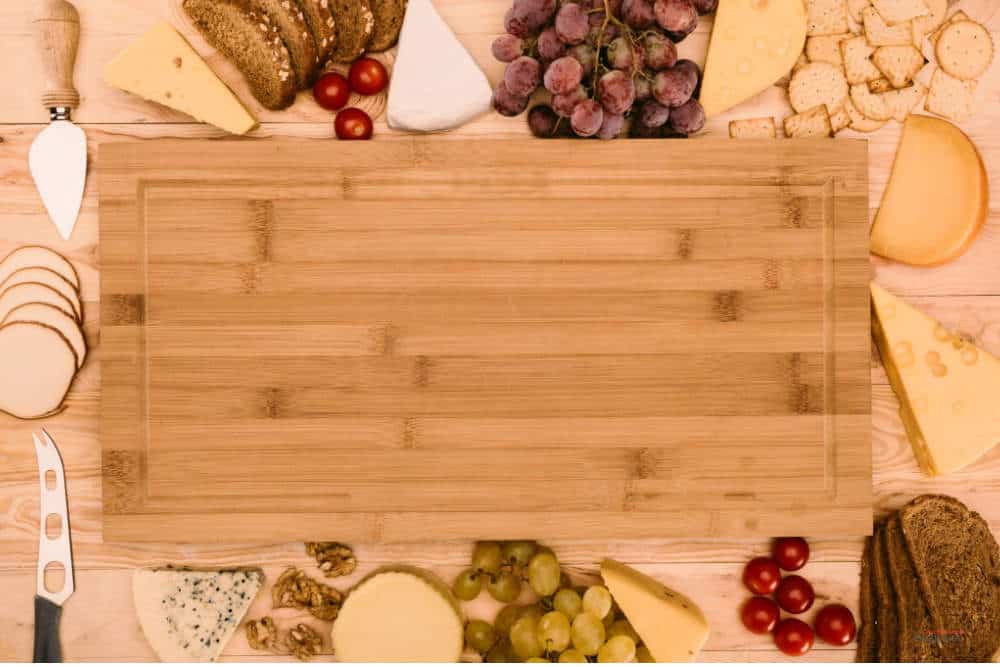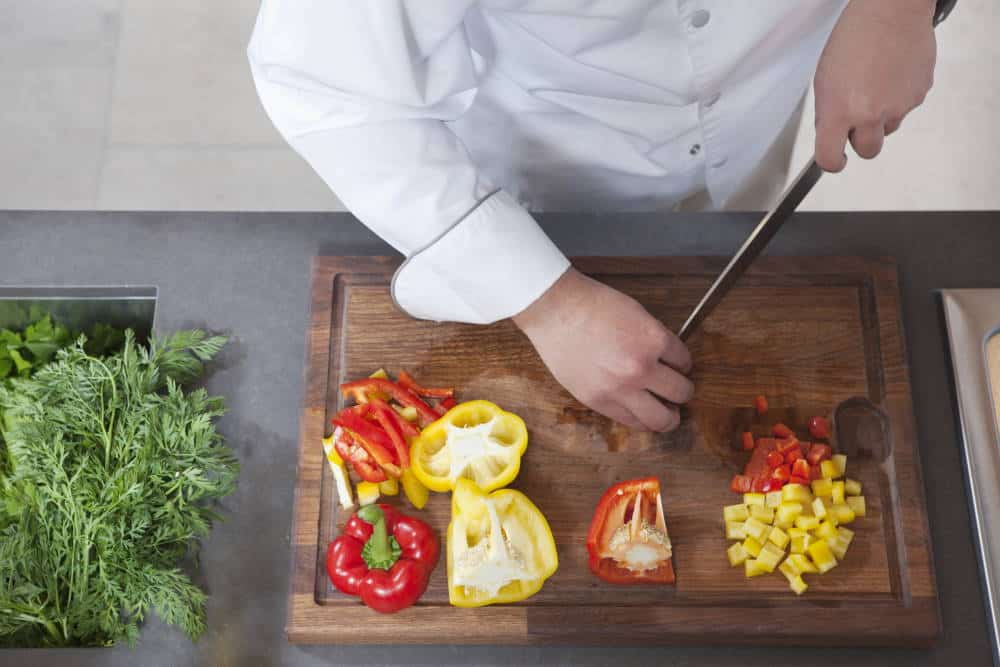Are you looking for a durable and efficient cutting board? Wood vs Bamboo Cutting Board is a common dilemma that people face while shopping for their kitchen. A cutting board is one of the essential kitchen utensils. For a newcomer picking a cutting board would pose a challenge.
You may have lots of questions and want to compare various types of cutting boards. Wood vs bamboo cutting boards, plastic cutting boards vs glass cutting boards, the board size and style to pick are the common questions that people ask.
Generally, the size and shape of the board isn’t a significant factor as people can determine them depending on their needs. On the other hand, picking the material of the board is crucial. A cutting board made of good material can not only affect the lifespan of the knives but also affect your health. As a result, you need to be careful while picking the best cutting board.
Which Cutting Boards are Available in the Market?
Before we discuss the wood vs bamboo cutting board topic, we need to talk about other materials as well, and why people avoid them.
Generally, you will come across four primary materials for cutting boards. Wood is the most common one, followed by plastic ones. Some people use glass cutting boards as well, and recently bamboo cutting boards have become the talk of the town.
Plastic Cutting Boards
Plastic cutting boards are one of the most affordable cutting boards, but at the same time, they are one of the most unhygienic ones.
Plastic cutting boards are not as robust as wooden or glass boards. As a result, regular use can lead to scratches and even gashes in the surface. These marks can become a hotspot for bacterial growth which can contaminate the food that you cut. This poses a considerable health risk as standard cleaning methods are not effective against them, mainly because they are in hard to reach places.
Mostly, people use a steam wash to kill the pathogens that live in the gashes and scratches on the board. However, doing so on low-quality plastic boards can damage them or even release harmful chemicals by breaking down the plastic.
Simply put, plastic cutting boards are not the way to go until you choose the premium quality ones, which are as expensive as the wooden ones, or you are willing to take extra precautions while cleaning the boards.
Glass Cutting Boards
Glass cutting boards look stylish and are way tougher than the plastic ones, or even wooden boards. However, this toughness doesn’t translate to durability. If you drop a glass board or apply too much pressure on it, there is a significant possibility that you might break it.
Some people might argue that the boards resist scratches to a great extent. This point is valid, and these boards don’t let bacteria such as E.Coli, Salmonella, and Listeria survive on their surface. As a result, the boards are great for people who need to use a cutting board sparingly. In case you are a person who needs to use a cutting board regularly, the boards can damage your cutting tools in a jiffy.
To conclude why people avoid glass and plastic cutting boards is that they are not durable. Additionally, plastic boards can lead to infection due to pathogens, and the glass cutting boards can damage your knives and other cutting tools in the long run.
Another huge reason to avoid these materials is their non-biodegradable nature.
Wooden Cutting Boards

Wooden cutting boards are the go-to option for anyone who has been doing kitchen work for a while, and also for newcomers. It is strong, offers decent scratch resistance (hardwood boards), and most importantly, possesses antibacterial properties.
These boards can be used regularly without any risk of damaging the cutting tools, and you don’t need to take extra care in cleaning the boards to prevent germ growth.
The best wooden cutting boards are expensive, but their features make them worth the price. So, if you want the best cutting board in the market and don’t want to spend a lot of time looking at different variants, pick a wooden cutting board. It will serve you for a long time without causing any issues.
Bamboo Cutting Boards

As we know, bamboo is a type of fast-growing grass that is tough. As a result, the best bamboo cutting boards are not only robust but also cost only a fraction of the price of a wooden board. These boards share a lot of similarities with the wooden boards and have similar antimicrobial properties.
The material is lightweight, and a lot of environmentalists prefer these boards over the traditional ones.
One main concern about the bamboo cutting boards is that they splinter if you don’t take good care of them. As a result, you need to apply oil on its surface regularly. The bamboo boards have similar porosity to that of wooden boards, and at the same time, they resist scratches. This porosity is a significant factor behind the boards’ antibacterial properties.
The antibacterial property and the resistance to scratches make bamboo boards one of the most popular alternatives to wooden cutting boards. The low price of bamboo means that you can get one of the best bamboo cutting boards at the price of a plastic or low-end wooden cutting board.
You might wonder if the bamboo boards are so great why do people still pick wooden boards. The reason is quite simple. Due to its low price and high availability, anyone can make a bamboo cutting board. So, you will find it challenging to identify the best bamboo cutting board in the market.
Additionally, to keep the price down, some manufacturers use formaldehyde-based glues to keep different layers of these bamboo boards together. Formaldehyde is a poisonous substance if consumed by humans. So, there is a slight risk of poisoning if the chemical seeps through the layers and makes its way to the food.
Lastly, the bamboo cutting boards are rigid and might cause more damage to the knives and other cutting tools when compared to the wooden cutting boards.
Wood vs Bamboo Cutting Board: Which Should You Choose?
As you have read, bamboo and wooden cutting boards have different advantages and disadvantages. Still, you might have some doubts regarding the different boards. So, here is a quick comparison that would help you choose the best cutting board for your needs.
Bamboo cutting boards are a lot cheaper when compared to wooden boards. At the same time, they offer a lot of properties that traditional maple wood cutting boards offer. Due to this reason, if you want an affordable cutting board to use sparingly, getting one of the best bamboo cutting boards would be a great option.
On the other hand, you might be a person who needs to use a cutting board all the time. In this case, getting a cheap bamboo cutting board could be harmful due to a couple of reasons. First of all, the formaldehyde used to glue to the board could contaminate the food item and lead to health issues.
The second reason to avoid bamboo cutting boards is their hardness. These boards are a lot harder than wooden boards and will lead to more wear and tear of the kitchen tools.
Wooden Cutting boards are the most popular type of cutting boards and are made of different kinds of wood. These different varieties of wood, such as oak, maple, etc. have different properties that affect the wear and tear of the knives and also the antibacterial properties of the board. If budget is not a concern and you can take good care of the cutting board, wooden boards are the best options out there.
Cleaning of Wooden or Bamboo Cutting Boards
We’ve put in ample research to demonstrate the right way of taking care of your cutting boards. Here are a few ways of maintaining the health of this kitchen asset.
The best way to clean your cutting boards is to wash them properly with soap and water. Slightly warm water would give you better results. While washing a cutting board, ensure that you do it thoroughly, and don’t skip the sides and underside of the boards.
Seasoning the Board
A lot of boards come pre-seasoned. Still, it is an excellent habit to season the board before use. Applying a layer of wax or oil on the board prevents water from seeping into the board and damaging it over time. Applying oil to the board regularly is a good practice, even if the board is already seasoned.
Sanitizing the Cutting Board
Wood and bamboo cutting boards are well-known for their antibacterial properties. However, there is no such thing as being too careful. To sanitize your cutting board properly, clean the board by placing it under running water after use to remove any remaining food particles from the surface.
You can also use a sponge to clean the surface of the board thoroughly. Once you have cleaned the board, run some hot water over it to kill the microbes. Finally, dry the board with a kitchen towel and let it dry overnight before using it again.
Putting a Cutting Board in a Microwave
When it comes to using a dishwasher to clean a cutting board followed by putting it in an oven for killing germs, plastic boards are not to be kept in ovens unless they are made to do so. On the other hand, wooden or bamboo ones can be sanitized by this method. Generally, you should check the details of the cutting board to make sure that it is safe to put in a microwave or clean in a dishwasher.
Putting a wooden or bamboo microwave in the microwave at 194 to 203 degrees Fahrenheit for five to six minutes is an excellent way of sanitizing the boards.
FAQs
Q. Are Bamboo Cutting Boards Good for Slicing Meat?
Yes, bamboo cutting boards are good for slicing meat along with fruits and vegetables. Just make sure that you clean the board before moving on to fruits or vegetables after slicing meat to avoid cross-contamination.
Q. Which Material Cutting Boards Should I Avoid?
Glass and Plastic cutting boards are the ones you should avoid. Avoid glass boards in particular as they are fragile and damage the knives quite easily.
Q. Which Wood Variety Is Best for Cutting Boards?
Chefs and epicureans prefer hard maple or sugar maple wood cutting boards. Walnut and cherry wood cutting boards would also be an excellent choice.
Q. How Frequently Should I Oil My Cutting Board?
It depends how often you use the board. People who use their boards regularly, oil the boards every month. However, it is a good idea to oil a cutting board once every three to four months.
Q. Is It Safe to Place Cutting Boards In Oven?
It is completely safe to place wooden and bamboo cutting boards in the oven. However, you should refrain from putting a plastic cutting board in the oven unless it has been deemed safe to do so.
Final Words
We all have faced a situation where we were confused about the cutting board that we should buy for our kitchen. The size and shape of the board don’t matter as much as the material. Generally, it is a good idea if you want to avoid plastic or glass cutting boards.
They are fragile and damage the knives, respectively. A wood or bamboo cutting board would be a better option with the wooden cutting board being the best choice unless you are on a budget. These two boards have antibacterial properties and last a lot longer than other materials.
